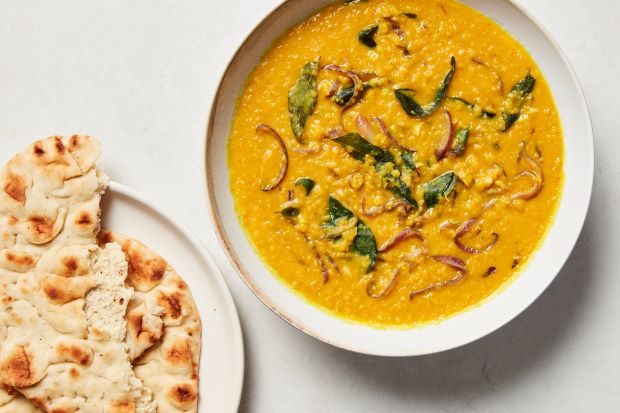The many sides of curry leaves

By Zinara Rathnayake
At my parents’ home in Kurunegala, Sri Lanka, as at many others across South Asia, curry leaf trees grow in the backyard, suffusing the air with a slight earthiness. That scent only intensifies when the fresh leaves sizzle in coconut oil, an integral step in so much of our home cooking.
If you’ve long been using curry leaves, you know they bring a dish together, making it richer, more robust. A sprig or two elevates, but doesn’t dominate, other flavours. Once fried, they release their sweet, mildly citrusy aroma into the fat, scenting and seasoning vegetables, fish, meat and even rice.
In South India, where their use dates back centuries, they are sautéed in oil for nadan kozhi, a spice-laden Keralan chicken curry, and ground into a paste to make karuveppilai thokku, a popular condiment.
And, in Sri Lanka, they flavour kaha bath, a special-occasion rice dish, in which the leaves are cooked in shimmering butter and turmeric, and kola kenda, in which they’re blended with coconut milk and rice, then boiled and served at breakfast. Of all the things Sri Lankans use curry leaves for, my favourite is parippu themparaduwa, a simply seasoned tempered dal.
Curry leaves are small, slender and green, and their flavour is often likened to that of lemon grass, asafoetida and citrus, to which they are botanically related. But there’s nothing quite like them.
Despite their name, curry leaves bear no relation to curry powder. The English word ‘curry’ originates from the British colonization of India and is derived from the Tamil term kari.
Although the leaves are often simmered in many dishes, they’re usually not eaten. That is, of course, unless the herb is crisped and used as garnish, scattered atop snack mixtures or rice.
The herbal aroma and taste of the leaves lend themselves to sambals and dips as well. They can also be steeped in boiling water for a few hours for an herbal tea. Just don’t eat them raw, as they’re sharp in flavour and unpleasantly chewy in texture.
Buy them fresh, then wrap fresh sprigs in paper towels and store them in a sealed container away from the sun and moisture. (They’ll last for about a week in the refrigerator and two months in the freezer.) But if you can’t find fresh ones, don’t fret. Dried and frozen leaves also work fine in most dishes, and the dried leaves can be stored in the freezer to preserve their scent.
—
RECIPE:
Parippu Themparaduwa (Dal with curry leaves)
This Sri Lankan dal of tender lentils, like other dals on Sri Lankan tables, are central to every meal and usually served with several other dishes, such as kukul mas maluwa (chicken curry). Because it is part of a larger meal, dal is often seasoned simply. This version is as well, but it is richer in taste from curry leaves, which infuse the lentils with their flavour. Dry or frozen curry leaves are fine substitutes if you can’t find fresh ones. You can add some cumin or coriander powder, too, if you’d like, or skip the Maldive fish flakes for a vegan dish. This dal is easy to cook and can be refrigerated in a covered container for up to three days. Serve with long-grain rice, bread or any of your favourite roti or other Indian flatbreads.
Yield: 4 to 6 servings
Total time: 45 minutes
Ingredients:
1 1/2 cups masoor dal (red lentils)
1 teaspoon ground turmeric
1 teaspoon ground cayenne
2 teaspoons Maldive fish flakes (optional; see tip)
3 tablespoons coconut oil
20 fresh curry leaves, plucked off the stems (1/4 cup), or use dried or thawed frozen curry leaves
1 small red onion, sliced thin
6 garlic cloves, finely chopped
1 teaspoon finely chopped fresh ginger
Salt
Cooked rice or roti, for serving
Preparation:
- Put masoor dal in a medium bowl, cover with water and rinse thoroughly. Drain and repeat twice more until the water runs clear.
- Transfer dal to a medium saucepan and add 3 cups water. Bring to a boil over medium heat. Cook, uncovered and stirring occasionally, until the water has absorbed and the dal has cooked through and softened, about 15 minutes.
- Turn off the heat and add ground turmeric, cayenne and fish flakes, if using. Mix well.
- In a large nonstick pan, heat coconut oil over medium. Add curry leaves and onion, and cook, stirring often, until the onion has softened, about 5 minutes. Add garlic and ginger, and cook, stirring, until fragrant, 1 to 2 minutes. Add the dal mixture and stir well. Add 1/4 cup water, reduce heat to medium-low and simmer for 3 to 5 minutes. Season to taste with salt and serve with rice or roti. The curry leaves aren’t meant to be eaten but can be served with the dal, then discarded after the meal.
TIP: Maldive fish flakes come from dried and cured tuna. They’re similar to dried anchovies, dried shrimp and bonito flakes. Packed with umami, they are frequently used in sambals and curry dishes in Sri Lanka and can be stored in a tightly sealed jar for up to 1 year. You can find them in Indian or Sri Lankan grocery shops or online.
-New York Times

